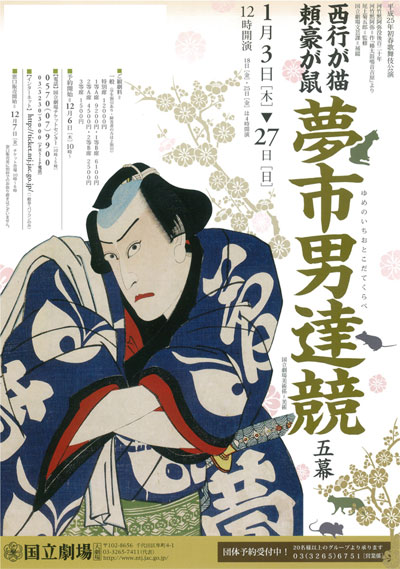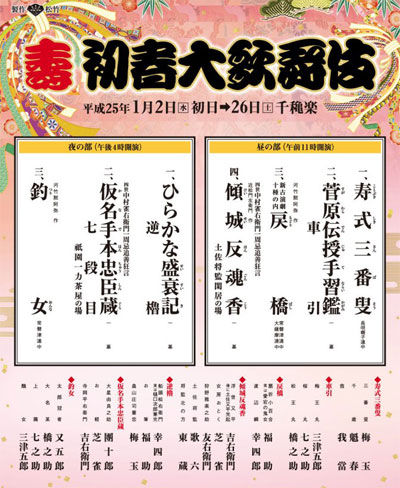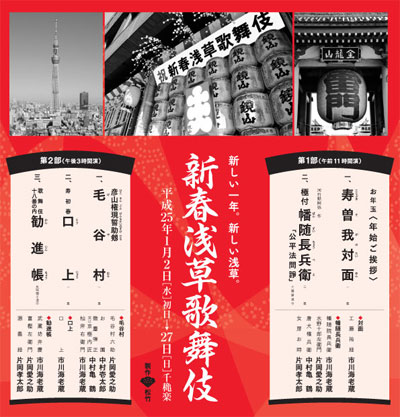| JANUARY 2013 |
|
2 in ďsaka (Sh˘chikuza), 6 shows in T˘ky˘ (National Theatre, Asakusa K˘kaid˘, Shinbashi Enbuj˘, Zenshinza Gekij˘)!
|
| Sh˘chikuza (ďsaka) |
| Dates | 1 ~ 26 January 2013 (Kotobuki Hatsuharu ďkabuki) Congratulation Early Spring Grand Kabuki |
| MatinÚe | |
| Evening | |
| Casting |
Ichikawa Ennosuke, Ichikawa En'˘, Sakata T˘jűr˘, Nakamura Kanjaku, Nakamura Senjaku, Kataoka Hidetar˘, Ichikawa Chűsha, Ichikawa Ukon, Ichikawa Emiya, Ichikawa En'ya, Band˘ Takesabur˘, Ichikawa Monnosuke, Ichikawa Juen, Ichikawa Emisabur˘, Band˘ Shinsha, Ichikawa K˘tar˘, Ichikawa Shun'en, Kamimura Kichitar˘ |
| Comments |
The actors Ichikawa En'˘ II, Ichikawa Ennosuke IV and Ichikawa Chűsha IX celebrate their shűmei in ďsaka at the Sh˘chikuza.
|
 |
| National Theatre (T˘ky˘) |
| Dates | 3 ~ 27 January 2013 (Hatsuharu ďkabuki) Early Spring Grand Kabuki |
| Program |
Yume no Ichi Otokodate Kurabe |
| Casting |
Onoe Kikugor˘, Nakamura Tokiz˘, Onoe Kikunosuke, Ichikawa Danz˘, Ichikawa Sadanji, Onoe Sh˘roku, Sawamura Tanosuke, Band˘ Hikosabur˘, Ichimura Manjir˘, Kataoka Kamez˘, Kawarasaki Gonjűr˘, Band˘ Kamesabur˘, Band˘ Kametoshi, Onoe Ukon, Nakamura Baishi, Nakamura Mantar˘, Fujima Taiga |
| Comments |
The 120th anniversary of the death of Kawatake Mokuami is celebrated at the National Theatre
with the revival of a long-forgotten drama, "Yagura Daiko Otomo Yoshiwara", which was premiered in the 2nd lunar month of 1866 at the Ichimuraza. Because of some refurbishment, a brand new title is used: "Yume no Ichi Otokodate Kurabe" ( |
 |
| Shinbashi Enbuj˘ (T˘ky˘) |
| Dates | 2 ~ 26 January 2013 (Kotobuki Hatsuharu ďkabuki) Congratulation Early Spring Grand Kabuki |
| MatinÚe |
Sugawara Denju Tenarai Kagami (Kurumabiki) Keisei Hangonk˘ (Domo Mata) |
| Evening | |
| Casting |
Matsumoto K˘shir˘, Nakamura Kichiemon, Band˘ Mitsugor˘, Nakamura Hashinosuke, Nakamura Shibajaku, Nakamura Fukusuke, Kataoka Gat˘, Nakamura Baigyoku, Nakamura Kaishun, ďtani Tomoemon, Nakamura Shichinosuke, Nakamura Karoku, Nakamura Matagor˘, Nakamura T˘z˘, Nakamura Kinnosuke, Band˘ Yajűr˘, Nakamura Kash˘, Ichikawa Komaz˘, Band˘ Shűch˘, Ichimura Kakitsu, Sawamura Yoshijir˘, Sawamura S˘nosuke, Kataoka Shinnosuke, Matsumoto Kingo, ďtani Keiz˘, Nakamura Matsue, ďtani Hirotar˘, ďtani Hiromatsu, Band˘ Minosuke, Nakamura Kotar˘, Nakamura Kunio |
| Comments |
The 1st anniversary of the passing away of Living National Treasure Nakamura Jakuemon IV is celebrated at the Shinbashi Enbuj˘ with the staging of two of his favourite dramas, "Domo Mata" and "Gion Ichiriki Jaya". Nakamura Jakuemon IV's son Nakamura Shibajaku VII plays the roles of Otoku in the former and Okaru in the latter.
|
 |
|
|||
| Dates | 2 ~ 27 January 2013 (Shinshun Hanagata Kabuki) New Year Young Actors Kabuki |
||
| MatinÚe | |||
| Evening | |||
| Casting |
Ichikawa Ebiz˘, Kataoka Ainosuke, Kataoka Takatar˘, Kamimura Kichiya, Kataoka Ichiz˘, Nakamura Kikaku, Nakamura Kazutar˘, Onoe Matsuya, Nakamura Tanenosuke, Nakamura Hayato, Nakamura Yonekichi, Band˘ Shingo, Nakamura Umemaru |
||
| Comments |
The yearly show for young promising actors at the Asakusa K˘kaid˘ in Asakusa, a lively and colorful neighboorhood that keeps the scent of old Edo.
|
||
 |
| Zenshinza Gekij˘ (Kichij˘ji) |  |
| Dates | 2 ~ 9 January 2013 (Zenshinza Gekij˘ Fainaru K˘en) Zenshinza Gekij˘ Final Performances |
| Program | |
| Casting |
Fujikawa Yanosuke, Kawarasaki Kunitar˘, Arashi Yoshisabur˘, Yamazaki Tatsusabur˘, Anegawa Shinnosuke, Matsunami Kihachir˘ |
| Comments |
Final Performances at the Zenshinza Gekij˘. This theater, which was built by the Zenshinza troupe in 1982, will be destroyed after 30 years of activity.
|
|
|
| Contact | Main | Top | Updates | Actors | Plays | Playwrights | Programs | Links | FAQ | Glossary | Chronology | Illustrations | Prints | Characters | Derivatives | Theaters | Coming soon | News |